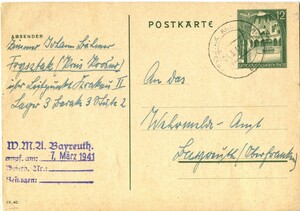WAYS TO SPECIALISE IN WWII GERMAN PHILATELY

There is technical philately and there is social philately.
In the 1930s, booklets became increasingly popular with the public, easy to carry in the wallet or bag. Not only were many combinations produced of se tenant stamps, some with slogan or propaganda labels, but also the collectors could purchase entire sheets that had not yet been assembled and guillotined into booklets. It was possible to divide these sheets at will, straddling the position where they would normally be cut for booklets, thus making special combinations not actually found in the finished booklets. Thus, a booklet collection of III Reich combination stamps can become a complex affair. Even the booklet covers and interleaving with advertising could vary; for example, we offer on page 5 the rare 1941 Hitler booklet with Van Dyke Kopierstift advertising and pane with Gluckwunsch greeting label (page 5, #026185). Coil stamps made a limited appearance and can be identified by the coil ends (page 18, #026177 for an example from Ostland).
Study of varieties has always been popular with collectors. These become meaningful when the variety only occurs on a certain stamp in the sheet (e.g. page 5, #026482, the 1945 Volksturm with a distinguishing variety in the corner block of four). Similar positional varieties can be found with overprints of the WWII Occupations, for example those for Macedonia on page 18, or the important Kurland item (page 16 #026378) showing all the listed varieties for that stamp visible together in one half sheet.
Local overprints are often border-line cases in stamp cataloguing. Some were prepared but not issued, such as the 1944 Warsaw Uprising set made by insurgents in the tragic revolt against Nazi rule (page 23, #026336).Michel's listings are needed here, more detailed than Gibbons.
For the postal historian, WWII was naturally rich in special types of mail, where communication was kept alive in difficult times. Censored mail exists on most pages of our list here, as well as diplomatic mail from occupied France to London (page 16, #023589) undercover mail from occupied Poland to food parcel services in Portugal (page 24), airmail to USA in the first years of the war when America was still neutral, or to Argentina throughout the war, concentration camp mail (Sachsenhausen on page 9), Forced labour camp mail (Poland on page 24), the ill-fated Frystak Ghetto in southern Poland (page 24 #026377).
And curiosities : did you know that the Germans managed to commemorate the 100th anniversary of the Penny Black in 1940? (See page 11, #026465).
For the social historian, the III Reich and WWII period is rich with propaganda and political themes, both on stamps and postmarks(page 13, Bohemia "Viktoria!!" cachets), or a world where military might (many feldpost items) and censorship ruled.
For those who combine history and geography, the war years saw German forces occupy most of Europe, beginning with the Sudetenland (page 6) and eventually extending to Pleskau (Pskov) in Russia (page 23), the "Palm Tree" Feldpost stamp of Rommel's troops in North Africa (page 14 #026198), or Kotor in Montenegro (page 16 #026385).
So, the III Reich and war years are always extremely popular with collectors for many reasons. I hope you find some interesting items on our site to add to your own special collection. I am always available to help with information if needed.
- Published
- 10/02/22 12:21:00 PM
